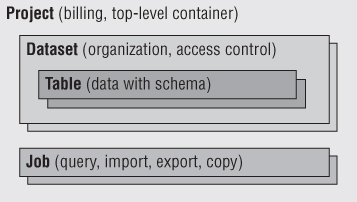Chapter 4Understanding the BigQuery Object Model
To understand how to use BigQuery, it is helpful to know a bit about the principal abstractions that it uses and a little bit of terminology. This chapter explains the key objects used by BigQuery and establishes a language for talking about them, which will be useful in subsequent chapters.
BigQuery is a structured data store; that is, it divides data into rows and columns. A collection of rows of data is called a table, just like in any relational database. Tables have a schema describing the columns of data they contain. Tables are grouped into datasets, which are logical collections of tables that can be shared. Datasets are owned by projects, which control billing and serve as a global namespace root, meaning all of the object names in BigQuery are relative to the project. Finally, all asynchronous operations BigQuery performs on behalf of users are done via jobs. Figure 4.1 shows the relationship between the primary BigQuery abstractions. This chapter describes these in more detail, starting with projects, then delving into data, and finishing up with jobs and what BigQuery can do with your data.

Figure 4.1 BigQuery API abstractions
Projects
You've already seen and created a project in Chapter 3, “Getting Started with BigQuery,” but what is a project exactly? Projects combine a number of somewhat disparate functions—naming, ...
Get Google BigQuery Analytics now with the O’Reilly learning platform.
O’Reilly members experience books, live events, courses curated by job role, and more from O’Reilly and nearly 200 top publishers.

